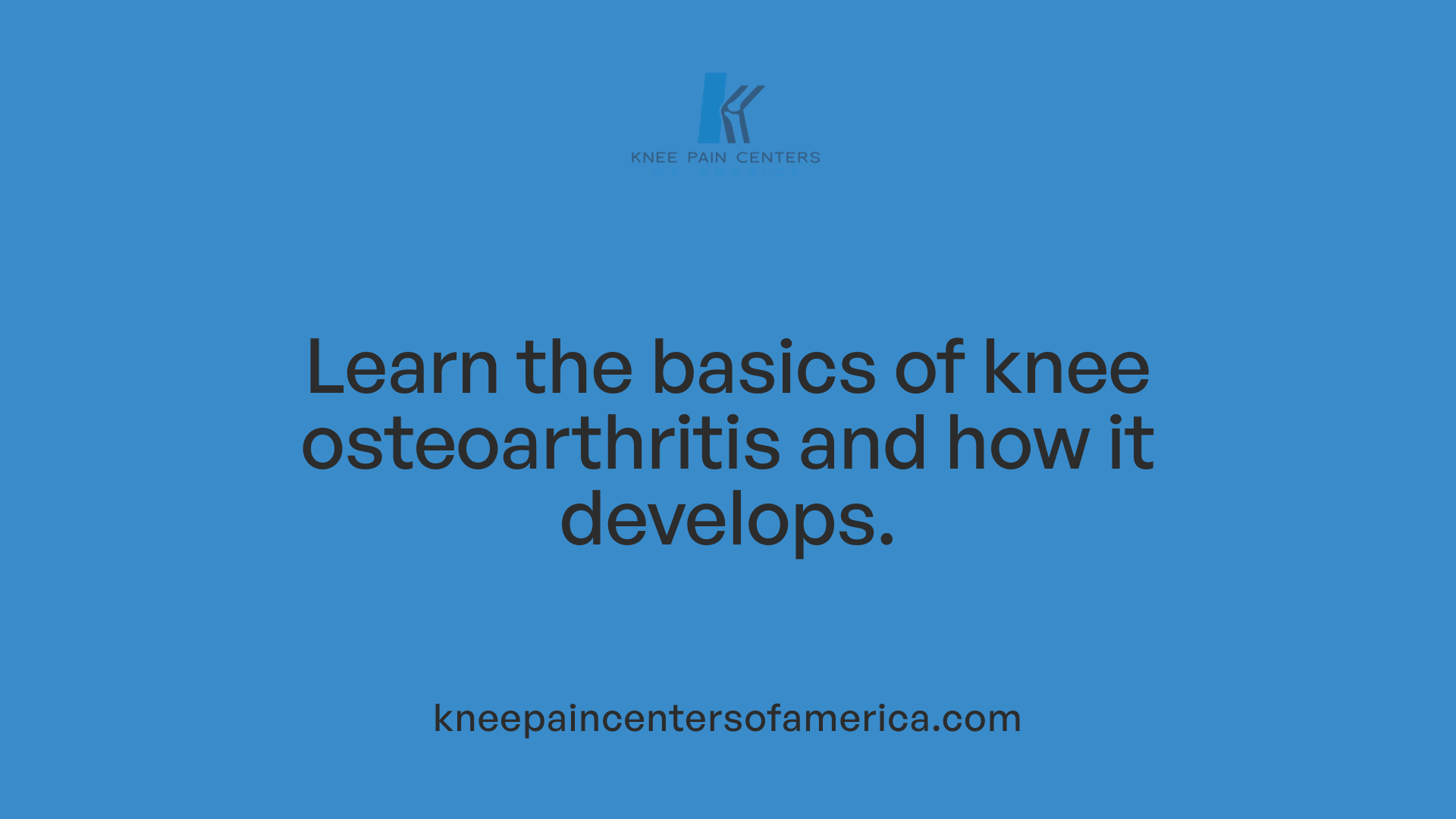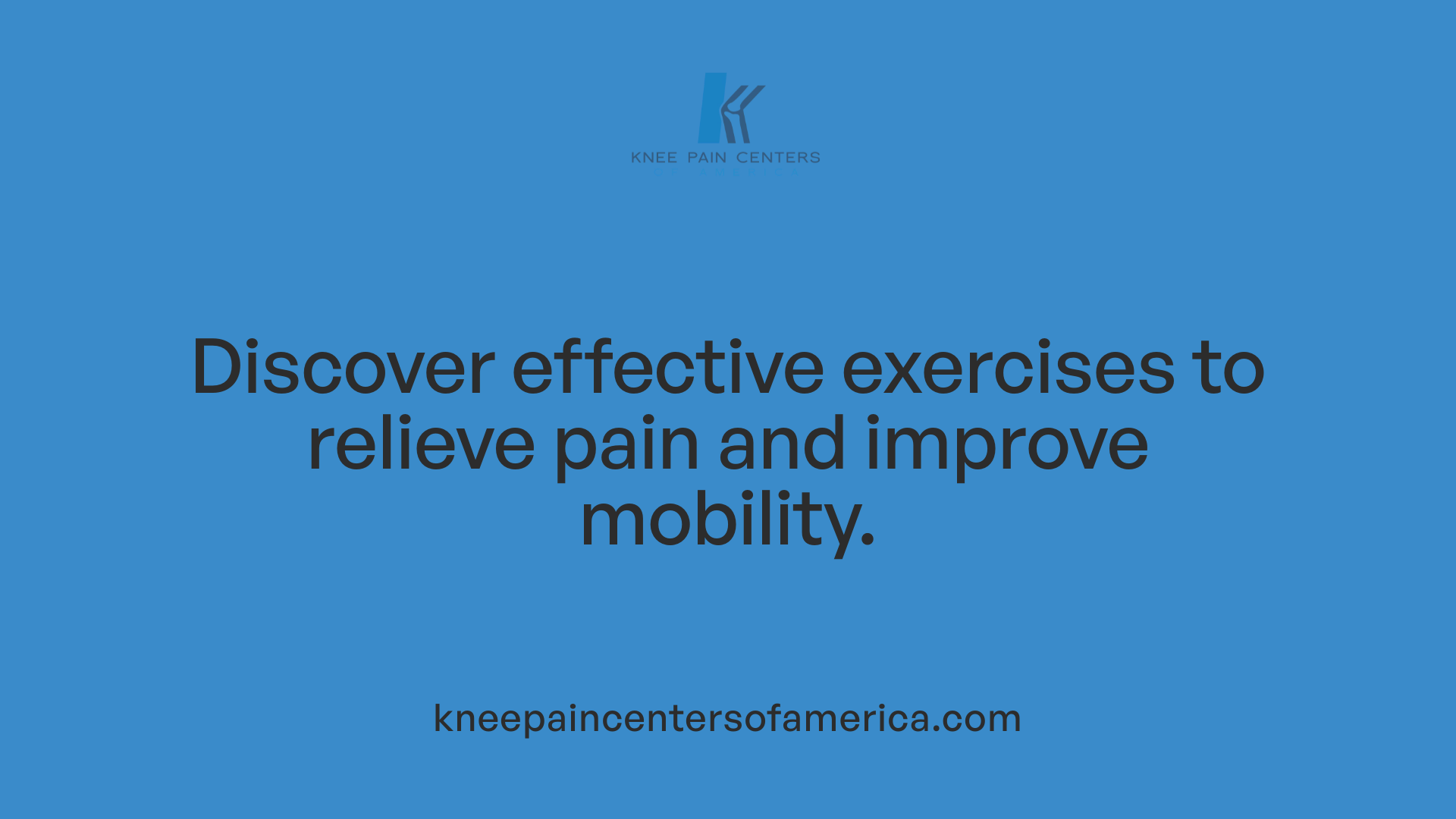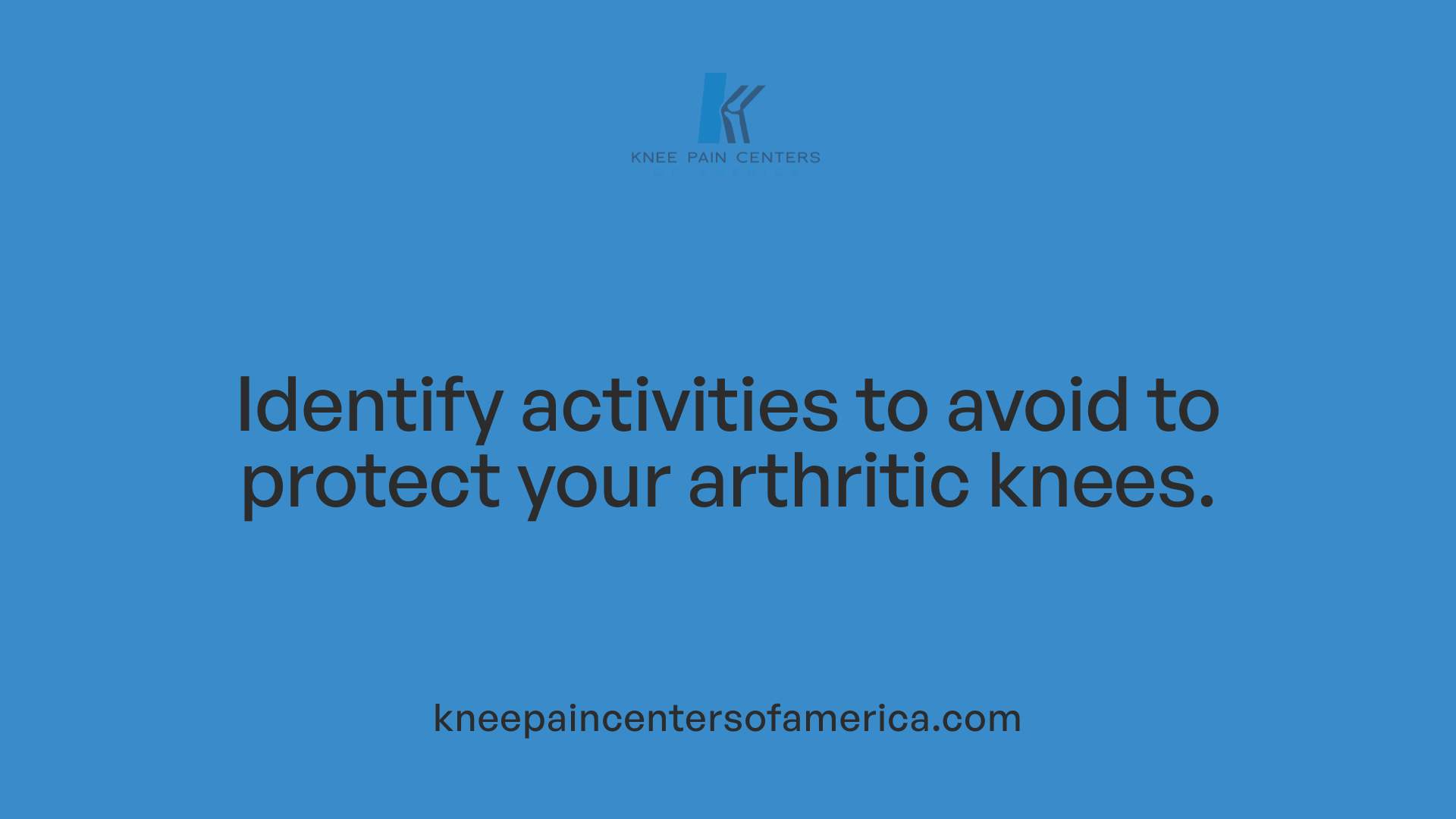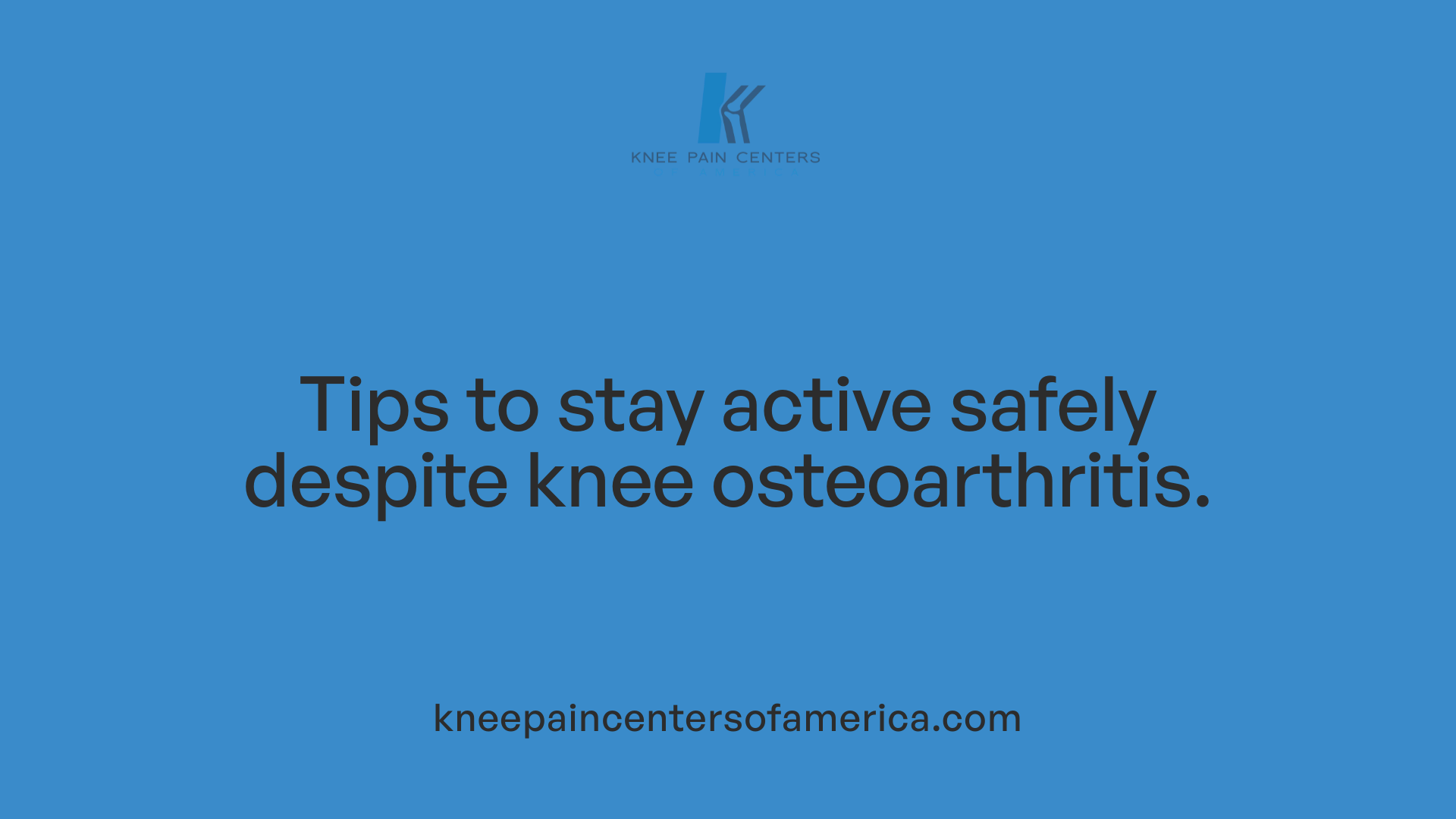Maintaining Activity with Arthritic Knees
Living with knee osteoarthritis (OA) presents challenges for staying active without aggravating symptoms like pain and stiffness. However, regular physical activity remains a cornerstone of management to ease discomfort, improve function, and sustain quality of life. This article explores evidence-based exercises, medical treatments, and practical tips to support those with arthritic knees in maintaining an active lifestyle safely and effectively.
Understanding Knee Osteoarthritis and Its Impact

What is Knee Osteoarthritis and How Does It Develop?
Knee osteoarthritis (OA) is a common joint condition marked by the gradual loss of cartilage at the ends of bones. Cartilage normally serves as a cushion that allows bones to glide smoothly during movement. When this cartilage deteriorates, bones begin to rub against each other. This friction leads to inflammation, resulting in pain, stiffness, and reduced joint mobility.
What Symptoms Are Characteristic of Knee Osteoarthritis?
The primary symptom experienced by individuals with knee OA is pain, especially during weight-bearing activities like walking or climbing stairs. Other symptoms often include morning stiffness, a grating sensation known as crepitus, and decreased range of motion. These symptoms can greatly impact daily activities and overall quality of life.
Which Factors Increase the Risk of Developing Knee Osteoarthritis?
Several risk factors contribute to the development of knee OA:
- Age: Incidence increases as people grow older.
- Genetics: Family history can play a role.
- Biomechanical and Biological Factors: Abnormal joint alignment or previous injuries.
- Excess Weight: Carrying extra body weight significantly raises stress on weight-bearing joints such as the knees, accelerating cartilage breakdown.
- Activity Levels: Both sedentary lifestyles and high-impact repetitive loading can influence progression.
Understanding these factors helps in tailoring prevention and management strategies to slow disease progression and reduce symptoms.
The Role of Exercise in Managing Arthritic Knees

Benefits of exercise for pain relief and mobility
Exercise plays a critical role in managing knee osteoarthritis (OA) by alleviating pain and enhancing joint mobility. Regular physical activity helps maintain muscle strength around the knee, which supports joint stability and decreases further joint deterioration. Aerobic exercises such as walking, swimming, and cycling not only reduce pain but also improve function and delay disability. Additionally, aquatic exercises are particularly beneficial for those with obesity due to the buoyancy reducing joint load.
Types of exercise recommended for knee OA
A comprehensive exercise regimen for knee OA focuses on flexibility, strength, and endurance. Strengthening the quadriceps, hamstrings, and gluteal muscles is essential for supporting knee extension and mobility, with exercises like straight leg raises, mini squats, bridging, and step-ups often recommended. Flexibility exercises such as hamstring and calf stretches improve joint mobility and should ideally be performed daily when pain is minimal. Low-impact aerobic activities, including swimming and cycling, provide cardiovascular benefits without excessive joint stress. Resistance training utilizing body weight, resistance bands, or machines further enhances muscle support of the knee. Balance exercises, such as single-leg stands and tandem balance, contribute to joint stability and injury prevention.
The importance of gradual progression and avoiding high-impact activities
It is important to start exercise programs gently, beginning with one set of 3 to 4 repetitions, and progressively increasing intensity to build strength while preventing overexertion. High-impact activities like running and jumping are discouraged because they can worsen symptoms. Patients should monitor for any increase in pain after exercise; if this occurs, consulting a healthcare professional for tailored guidance is recommended. Proper footwear and gait modification can also reduce abnormal joint stresses during activity.
How can osteoarthritis of the knee be managed through medical interventions?
Exercise remains a foundational treatment for knee OA, complemented by medical interventions such as analgesics (acetaminophen and NSAIDs), weight management to reduce joint load, and use of supportive aids like braces or canes. Combining these strategies with individualized rehabilitation that includes manual therapy and education helps optimize outcomes, especially in athletic individuals.
| Exercise Type |
Examples |
Benefits |
| Aerobic |
Walking, swimming, cycling |
Reduces pain, improves cardiovascular health, limits joint stress |
| Strength Training |
Mini squats, straight leg raises, bridging |
Supports joint stability and muscle strength |
| Flexibility Exercises |
Hamstring and calf stretches |
Enhances joint mobility and reduces stiffness |
| Balance Training |
Single-leg balance, tandem stance |
Improves coordination and prevents falls |
In summary, tailored, gradual exercise programs focusing on low-impact aerobic activities, strength, flexibility, and balance are essential to effectively manage arthritic knees and improve quality of life.
Recommended Exercises for Strength and Flexibility

Which Specific Exercises Are Beneficial for Knee Osteoarthritis?
Various targeted exercises have proven advantageous for individuals managing knee osteoarthritis (OA). These include bridging, mini squats, straight leg raises, quad sets, side-lying leg raises, step-ups, sit-to-stand movements, and balancing routines such as tandem and single-leg balances. Stretching exercises such as hamstring stretches, calf stretches, and lying quad stretches also play an essential role in maintaining flexibility and reducing stiffness.
How Can Resistance Bands and Aquatic Exercises Help?
Using resistance bands provides safe and progressive muscle strengthening, particularly for the quadriceps, hamstrings, and gluteal muscles that support knee extension and stability. Aquatic exercises like swimming and water aerobics are highly recommended because water buoyancy decreases joint loading, which reduces pain during movement while still offering resistance to strengthen muscles effectively.
Why Are Daily Flexibility Exercises Important?
Performing flexibility exercises daily — ideally when pain is minimal — is crucial to improving joint mobility and reducing stiffness. Regular stretching of the quadriceps, hamstrings, and calf muscles helps maintain a healthy range of motion, making everyday activities easier and lowering the risk of further joint deterioration.
In summary, non-surgical management of knee OA includes exercises focusing on strengthening key muscle groups and enhancing joint flexibility. Incorporating resistance band training and water-based workouts alongside daily stretches can significantly ease pain, support joint function, and improve overall mobility.
Avoiding Activities That Aggravate Knee Symptoms

Which high-impact exercises should be avoided to protect arthritic knees?
High-impact exercises such as running, jumping, and high-impact aerobics can worsen knee osteoarthritis symptoms. These activities increase joint stress and may lead to more pain and inflammation due to repetitive loading of the already compromised cartilage.
How can activity levels be modified to suit symptoms and environmental conditions?
It is important for individuals with knee osteoarthritis to adjust their activity intensity according to their pain levels and weather conditions. When joint pain worsens, reducing activity or switching to lower-impact options can help prevent joint damage and discomfort. Cold or damp weather may exacerbate stiffness and pain, so indoor exercises or gentler routines may be preferable during such times.
What are some joint-friendly workout alternatives to consider?
Low-impact exercises like yoga and Pilates offer effective alternatives that reduce strain on the knees while improving flexibility, strength, and balance. These gentle forms of exercise can be performed indoors, making them ideal in cold weather or when avoiding outdoor joint stress is needed. Additionally, swimming and water aerobics provide resistance without heavy joint loading through the buoyancy of water, making them another excellent choice for knee-friendly workouts.
These modifications help maintain physical activity safely, improving symptoms and slowing osteoarthritis progression without aggravating the knees.
Medical Interventions to Complement Exercise Therapy
What are the most effective medical treatments for knee pain?
Managing knee osteoarthritis involves more than just exercise; medical treatments play a significant role in alleviating pain and improving joint function.
Oral pain relievers such as acetaminophen and non-steroidal anti-inflammatory drugs (NSAIDs) are commonly used to reduce inflammation and control pain symptoms. These medications help patients remain active and engage more effectively in physical therapy.
Supportive devices like knee braces and orthotic shoe inserts help by offloading stress from the knee joint and improving alignment. This mechanical support can lessen discomfort during daily activities and exercise.
Injection therapies provide direct intervention within the joint. Corticosteroid injections are effective for short-term pain relief by reducing inflammation quickly. Hyaluronic acid injections work differently by supplementing the natural joint lubrication, which may aid in reducing friction and delaying cartilage deterioration.
Combining these medical approaches with a tailored exercise program optimizes symptom management and enhances mobility. This integrative strategy supports a better quality of life for individuals with knee osteoarthritis.
Understanding Corticosteroid and Hyaluronic Acid Injections
What role do corticosteroid injections play in treating knee osteoarthritis?
Corticosteroid injections are commonly used to reduce inflammation inside the knee joint. By decreasing swelling and irritation, they provide short-term pain relief lasting from weeks up to a few months. Patients often experience improvements in symptoms such as stiffness and overall function during daily activities following these injections. However, corticosteroids do not stop the progression of osteoarthritis itself. Additionally, repeated injections can carry risks like cartilage damage, so their use is carefully monitored and usually considered part of a broader treatment approach.
How do hyaluronic acid injections benefit patients with knee osteoarthritis?
Hyaluronic acid injections help by supplementing the natural lubricating and shock-absorbing properties of the joint fluid. This can reduce pain, improve mobility, and sometimes slow joint cartilage breakdown. Relief from symptoms may last up to six months, making these injections a useful option especially for those delaying or avoiding surgery. While generally safe, their effectiveness can vary between individuals.
Considerations and timing for injection therapies
Injection therapy is often recommended after conservative measures, like exercise and weight management, have been tried. The choice between corticosteroids and hyaluronic acid depends on symptom severity, patient response history, and specific clinical factors. Because repeated corticosteroid injections can have side effects, hyaluronic acid may sometimes be preferred for longer-term symptom control. It's essential that injection use is customized by healthcare providers to each individual’s needs and monitored carefully to balance benefits and risks.
When Is Surgery Considered for Knee Osteoarthritis?
When is knee surgery considered necessary for osteoarthritis patients?
Knee surgery for osteoarthritis (OA) is generally considered only after conservative management strategies—such as medication, physical therapy, and lifestyle modifications—have failed to adequately control pain or improve joint function. Surgery becomes a viable option when there's severe joint damage characterized by significant cartilage loss, leading to persistent pain and disability.
Patient-specific factors such as age, overall health, activity level, and personal goals are important considerations in determining surgical need. Surgery is typically reserved for those experiencing substantial limitations in daily activities despite optimal non-surgical treatment.
Types of surgery including partial and total knee replacement
The two primary surgical interventions for knee OA are partial knee replacement and total knee replacement. Partial knee replacement involves resurfacing only the damaged compartment of the knee and preserves healthy tissue, making it suitable for localized OA. Total knee replacement involves replacing all the damaged joint surfaces with prosthetic components and is recommended for more widespread joint disease.
Risks and expected outcomes of knee surgery
While knee replacement surgery can provide significant long-term pain relief and improve mobility, it carries risks such as infection, blood clots, implant loosening, and limited range of motion. Post-surgical rehabilitation is essential to optimize outcomes and restore function. Overall, knee surgery offers substantial benefits for patients with advanced OA unresponsive to other treatments but requires careful patient selection and thorough preoperative counseling.
Weight Management and Its Impact on Arthritic Knees
How Excess Weight Increases Joint Stress
Excess body weight places additional pressure on weight-bearing joints, particularly the knees. This increased mechanical load accelerates the breakdown of cartilage, the protective tissue at the ends of bones, leading to greater pain and faster progression of osteoarthritis (OA). For every pound of excess weight, the knees experience an estimated four pounds of additional pressure, intensifying joint stress and inflammation.
Benefits of Weight Loss in Reducing Knee Pain and Slowing OA Progression
Losing weight can significantly alleviate the burden on arthritic knees. Even modest weight loss reduces joint pressure, which helps decrease pain and stiffness associated with OA. Reducing stress on the knee joints slows cartilage damage, potentially delaying the progression of osteoarthritis and improving overall joint function. Patients often notice improved mobility and lessened discomfort following weight reduction.
Integrating Diet and Exercise for Best Outcomes
Optimal management of knee OA involves combining a carefully planned diet with targeted exercise routines. Nutritional strategies focused on healthy, sustainable weight loss complement exercises that strengthen muscles supporting the knee, such as the quadriceps, hamstrings, and gluteal muscles. Low-impact aerobic activities like swimming, cycling, and walking enhance cardiovascular health and facilitate weight management while minimizing joint stress. Together, dietary changes and regular exercise form an effective approach to managing symptoms and maintaining an active lifestyle in individuals with knee osteoarthritis.
Non-Surgical Therapies for Knee OA Pain
Non-surgical treatments for osteoarthritis-related knee pain include weight loss, physical therapy exercises that strengthen surrounding muscles, and over-the-counter pain relievers like acetaminophen and nonsteroidal anti-inflammatory drugs (NSAIDs). Using walking aids, braces, or orthotic footwear can further support joint alignment and reduce discomfort. These combined measures provide symptom relief and improve joint function without invasive procedures.
Tailoring Exercise and Rehabilitation for Different Activity Levels
Customizing exercise programs for sedentary, overweight, and athletic individuals
Exercise prescriptions for knee osteoarthritis must be tailored to meet the unique needs of different patient groups. Sedentary or overweight individuals often benefit most from low-impact, aquatic exercises such as swimming or water aerobics. These activities leverage buoyancy to decrease joint load while providing resistance to gently build strength. Focus in these groups should be on flexibility routines performed daily to reduce stiffness and gradual strengthening of muscles like quadriceps, hamstrings, and glutes to improve knee support and mobility.
Athletic or highly active individuals with knee osteoarthritis require more advanced rehabilitation strategies. Their programs often include higher-resistance or high-speed strength training conducted safely under healthcare supervision. Exercises such as mini squats, step-ups, and resistance band training help maintain muscle strength without excessive joint strain. Balancing symptom control and maintaining performance capabilities is essential in this group.
Balancing symptom control with maintaining functional ability
A major challenge in managing knee osteoarthritis is reducing pain and inflammation while preserving or enhancing functional mobility. Exercise routines must avoid high-impact activities that exacerbate symptoms but encourage ongoing activity to slow disease progression. Starting with low repetitions and gradually increasing intensity helps prevent overexertion and flare-ups.
For all patients, appropriate activity levels help stimulate joint lubrication and endorphin release, which aid in pain relief while maintaining cardiovascular health. Monitoring discomfort during and after exercise is crucial; any worsening of pain should prompt consultation with a healthcare provider to adjust the plan.
Incorporating therapeutic modalities and gait training
In addition to exercise, therapeutic interventions enhance rehabilitation outcomes. Manual therapy techniques and neuromuscular electrical stimulation improve quadriceps strength and joint mobility. Gait modifications and perturbation training reduce abnormal loading on the knee joint during movement, potentially decreasing pain and preventing further damage.
Proper footwear and taping techniques also support joint alignment and unloading. A comprehensive rehabilitation plan that integrates these approaches alongside personalized exercise regimens and patient education delivers the best outcomes, especially for athletic individuals aiming to maintain performance.
| Patient Group |
Recommended Exercises |
Rehabilitation Focus |
| Sedentary/Overweight |
Aquatic exercises, flexibility stretches, low-impact strength training |
Reducing joint load, gradual strength building, improving flexibility |
| Active/Athletic |
High-resistance training, mini squats, step-ups, gait modification |
Balancing symptom control, maintaining performance, advanced strengthening |
| All Patients |
Monitoring pain, gradual progression, therapeutic modalities |
Preventing joint deterioration, improving mobility, pain management |
Practical Advice for Staying Active with Arthritic Knees

How Can Weather and Pain Levels Influence Exercise Choices?
Weather and pain levels significantly impact the ability to maintain an active lifestyle with arthritic knees. Cold weather, for instance, can worsen joint stiffness and pain, making outdoor activities more challenging. Patients are advised to modify their activity by opting for indoor exercises like yoga, Pilates, or weight training during such conditions to avoid aggravating symptoms.
Listening to one’s pain levels is crucial; exercises should not worsen pain. If knee pain intensifies after activity, it’s important to pause and consult a healthcare provider. Flexibility exercises are best performed when pain is minimal, ideally daily, to maintain joint mobility and reduce stiffness.
What Role Does Proper Footwear and Taping Play?
Proper footwear and taping techniques are essential components for managing knee osteoarthritis during physical activity. Footwear that provides adequate cushioning and arch support helps in maintaining joint alignment and absorbing impact, reducing abnormal joint stresses during movement.
Taping methods can support the knee by stabilizing the joint and improving biomechanical alignment. This can alleviate pain and prevent further joint damage. Patients should seek professional guidance on appropriate footwear choices and taping to ensure maximum benefit.
Why Is Patient Education and Healthcare Consultation Important?
Education empowers patients to understand their condition and tailor exercises accordingly. Healthcare professionals can design individualized rehabilitation plans that consider the patient’s activity levels, symptoms, and goals. This approach balances symptom control with functional maintenance.
Regular consultations help monitor progress and adapt exercises to prevent exacerbation. Healthcare providers may incorporate therapeutic modalities like neuromuscular electrical stimulation or manual therapy alongside exercises for optimal outcomes.
| Aspect |
Practical Tips |
Benefits |
| Weather & Pain Adaptation |
Choose indoor low-impact exercises during cold weather or flare-ups |
Maintains activity, reduces joint stress |
| Footwear & Taping |
Use cushioned supportive shoes and professional taping methods |
Enhances joint stability, reduces pain |
| Education & Professional Care |
Engage with healthcare providers for personalized plans |
Prevents injury, promotes effective management |
Maintaining Mobility and Quality of Life with Arthritic Knees
Knee osteoarthritis challenges many to remain active without worsening symptoms. Through a combination of appropriately tailored exercise routines that strengthen muscles and maintain flexibility, supported by medical treatments including medications, injections, and assistive devices, individuals can successfully manage pain and preserve function. Weight management and patient education play pivotal roles in this comprehensive approach. Collaboration with healthcare professionals ensures that physical activity remains safe and effective, empowering those with arthritic knees to sustain mobility and improve quality of life long term.
References